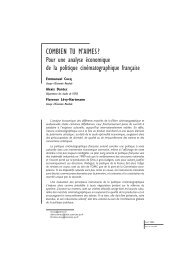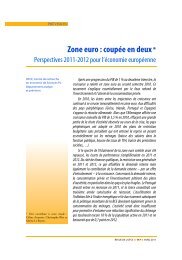direct multi-step estimation and forecasting - OFCE - Sciences Po
direct multi-step estimation and forecasting - OFCE - Sciences Po
direct multi-step estimation and forecasting - OFCE - Sciences Po
You also want an ePaper? Increase the reach of your titles
YUMPU automatically turns print PDFs into web optimized ePapers that Google loves.
Direct <strong>multi</strong>-<strong>step</strong> <strong>estimation</strong> <strong>and</strong> <strong>forecasting</strong><br />
which is referred to as the (φ, ξ) model <strong>and</strong> the <strong>forecasting</strong> model is, then, denoted by (1, θ). Tiao<br />
<strong>and</strong> Xu, then, derive the minimum of σ 2 (h, θ), for given h, <strong>and</strong> it is obtained for:<br />
⎧<br />
⎪⎨ (1 − √ c) (φ + c) −1 , for (φ, ξ) ∈ S,<br />
θ ∗ h =<br />
⎪⎩ 1, otherwise,<br />
[<br />
]<br />
where c = (1 + ξ) (φ − ξ) (1 − φξ) (1 + φ) φ h−1 − 1 <strong>and</strong> S is some region of [−1, 1]×[−1, 1] which<br />
they define. Let r (h; φ, ξ) be the ratio of σ 2 (h, θ ∗ h) over the MSFE implied by the true model; it is<br />
a measure of the efficiency loss. The authors show that r (1; φ, ξ) < 1.2 over a wide region around<br />
φ = ξ, or when φ > ξ > 0, or when 2 3<br />
< φ ≤ 1; <strong>and</strong> it is moderate over a large part of the parameter<br />
space, as is often the case in empirical work, <strong>and</strong> which is one of the reasons of the widespread use<br />
of the exponential smoothing formula. When (φ, ξ) vary, θ ∗ h is unity when φ is negative, or when<br />
ξ > φ. As regards the behaviour with respect to h, the supremum of r (h; φ, ξ), when φ > ξ > 0,<br />
is increasing the horizon but bounded as h → ∞ by 4/3. When comparing the DMS <strong>and</strong> IMS<br />
<strong>forecasting</strong> performances, the authors mention that the ratio σ 2 (h, θ ∗ 1) /σ 2 (h, θ ∗ h) is increasing in<br />
h for φ > ξ > 0 <strong>and</strong> it tends to 2 as the horizon goes to infinity.<br />
Under the general ARIMA case, in (11), Tiao <strong>and</strong> Xu then prove the consistency of the estimate<br />
̂θh (T ) of θ ∗ h obtained by minimizing (T − h) −1 ∑ T −h<br />
t=1 ê2 t+h,h<br />
, the in-sample average of the squared<br />
forecast errors: they show that, under some regularity assumptions:<br />
̂θh (T )<br />
→ θ ∗<br />
T →∞<br />
h,<br />
where θ ∗ h is a—the, if unique—minimizer of σ 2 (h, θ) over (−1, 1]. This result extends to forecasts<br />
generated from the FGP:<br />
(1 − L) b1 (1 − L s ) b2 y t = (1 − θ 1 L) (1 − θ 2 L s ) u t ,<br />
where {u t } is assumed to be i.i.d. Gaussian white noise, s ≥ 1, b 1 = 0 or 1, b 2 = 0 or 1, b 1 +b 2 > 0,<br />
<strong>and</strong> the data generating process of the series is<br />
φ (L) (1 − L) d1 (1 − L s ) d2 y t = ξ (L) ɛ t .<br />
The FGP includes here, inter alia, the ARIMA(0, 2, 2) non-stationary smooth trend model (s =<br />
1, b 1 = b 2 = 1), <strong>and</strong> the <strong>multi</strong>plicative non-stationary seasonal models (s = 12, b 1 = b 2 = 1) <strong>and</strong><br />
(s = 12, b 1 = 0, b 2 = 1).<br />
24








